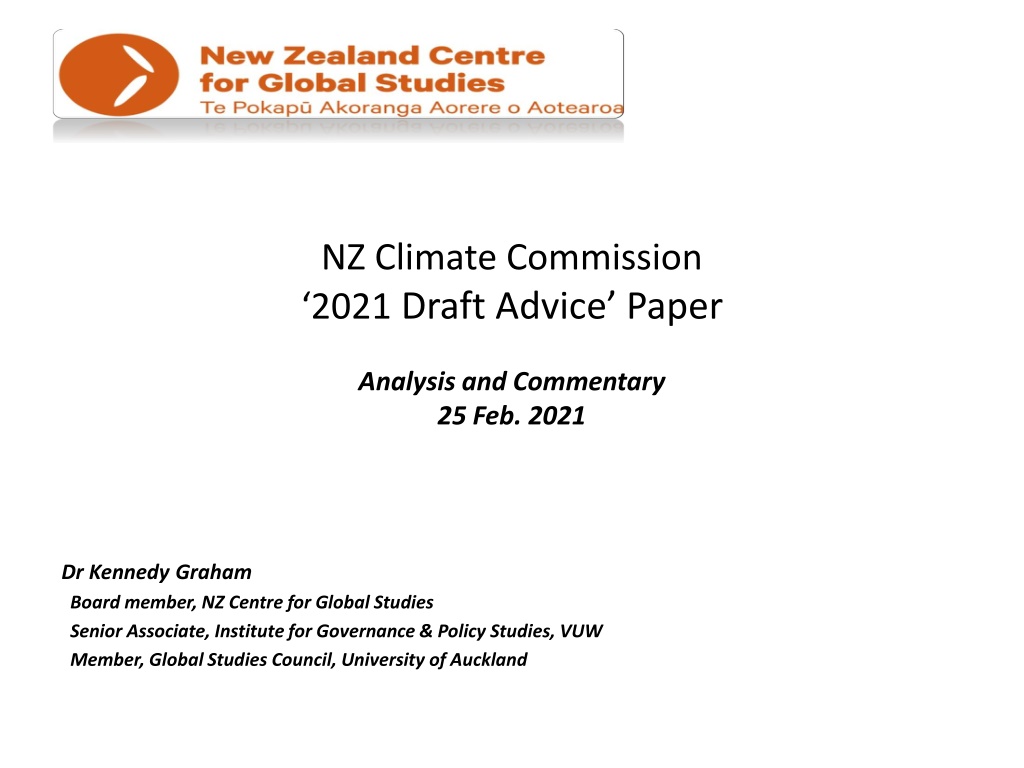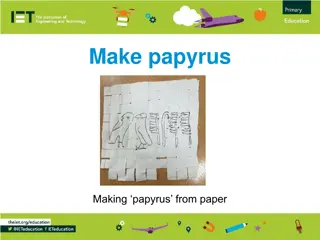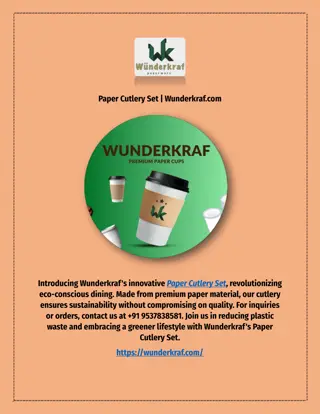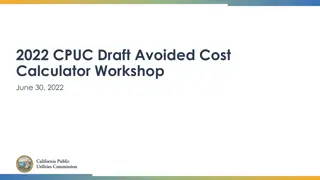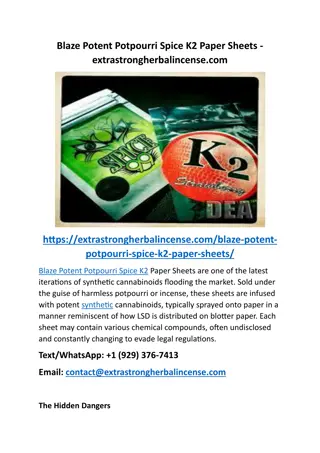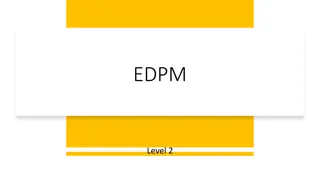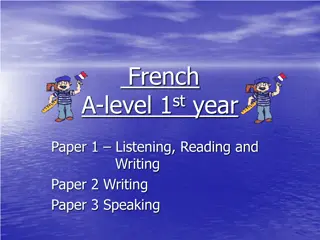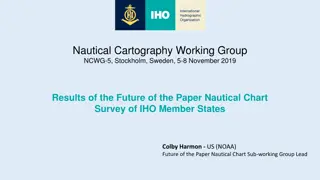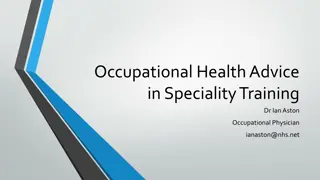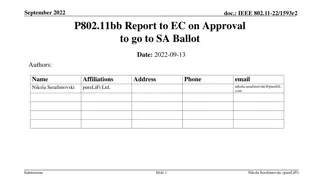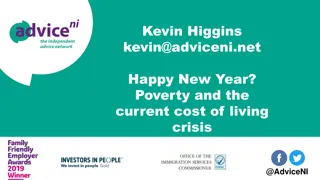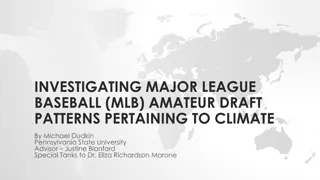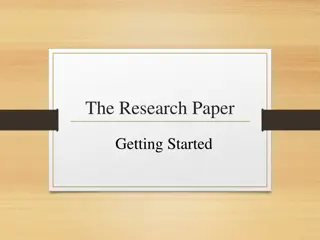Draft Advice’ Paper
Analysis and commentary on the NZ Climate Commission's 2021 draft advice paper by Dr. Kennedy Graham. The analysis covers comparisons with earlier NZ reports, personal comments, recommendations on applying UN principles, and a national conceptual framework. It delves into the context, content, timeframe, terms of reference, elements, scenarios, modelling, and statistics of the report. The description includes an overview, detailed descriptions, and critical actions suggested in the paper.
Download Presentation

Please find below an Image/Link to download the presentation.
The content on the website is provided AS IS for your information and personal use only. It may not be sold, licensed, or shared on other websites without obtaining consent from the author.If you encounter any issues during the download, it is possible that the publisher has removed the file from their server.
You are allowed to download the files provided on this website for personal or commercial use, subject to the condition that they are used lawfully. All files are the property of their respective owners.
The content on the website is provided AS IS for your information and personal use only. It may not be sold, licensed, or shared on other websites without obtaining consent from the author.
E N D
Presentation Transcript
NZ Climate Commission 2021 Draft Advice Paper Analysis and Commentary 25 Feb. 2021 Dr Kennedy Graham Board member, NZ Centre for Global Studies Senior Associate, Institute for Governance & Policy Studies, VUW Member, Global Studies Council, University of Auckland
UNEP: Emissions Gap Report 2020 for 1.5 C, 2030 gap = 10.5 Gt. CO -e 2
Overview 1. Description (a) Context & Content (b) Independent Reviews 2. Analysis (a) Comparison with Earlier NZ Reports (b) Personal Comment 3. Recommendations (a) Application of UN principles (b) National Conceptual Framework 3
1. DESCRIPTION (a) Context & Content Context Content (i) Timeframe (ii) Terms of Reference (i) Elements (ii) Scenarios (iii) Modelling (iv) Statistics (v) Conclusions 4
Context: (i) Timeframe CC Report Evidence Report 26 Jan. (650 pg.) Draft Advice Report 31 Jan. (180 pg.) 1 Feb. 28 March [was 14th] Consultation Final 31 May NZG Emissions Reduction Plan 31 Dec. 5
Context (ii) Terms of Reference ZCA (2019), amending Climate Change Response Act (2002) Targets & Budgets: Sect. 5 X (3) Six Budgets (three by 2021; 4th by 2025; 5th by 2030; 6th by 2035) Sect. 5 Y (1 & 2) ..expressed as a net quantity of CO2-e ; must include all GHGs Sect. 5 Z (1 & 2) Domestic as far as possible ; Off-shore if significant change of circumstances Sect. 5 ZA (1(c)) How to realistically , meet budgets & ultimately the 2050 target Sect. 5 Q (1) the 2050 target requires that LLG = net zero; SLG (Bio-methane) = 24% to 47% off 2017 Sect. 5 S Review 2050 target when preparing 4th Budget (i.e. in 2025) Govt. Reports: Sect. 5 K (1): two matters related to GHG emission reductions 1. Biogenic methane: eventual reductions needed 2. Review NZ NDC 2030 6
CONTENT (i) Elements Two components of the 2050 target : (net-zero LLG + SLG cut 24%-47% off 2017); Four scenarios (Headwinds, Behaviour; Technology; Tailwinds) One Pathwaywithin the scenario range (bounded by Headwinds/Tailwinds) Six pieces of advice in 4 categories: budget level; process; policies ( time-critical & necessary ) 17 critical actions 7
CONTENT (ii) Scenarios 1. Headwinds higher barriers to tech/behaviour changes; conservative improvements in technology beyond CPR (Current Policy Reference case) modest change from existing behaviour by people / businesses 2. Technology new technologies developed/deployed = faster emissions reductions available sooner, perform better or have lower costs = drive greater adoption. 3. Behaviour change in people/business preferences = behaviour change from high emitting activities conservative tech. progress (as in Headwinds) but barriers to adoption of existing tech. = lower 4. Tailwinds both tech./ behaviour change = potential upper bound for how far & fast beyond CPR NZ-CC: selects the lowest (Headwinds) & highest (Tailwinds) scenarios for its range ; then plots a single 2050 pathway within the range (out to 2035); then develops three Budgets (2021-25; 2026-30; 2031-35) based on the Pathway 8
CONTENT (iii) Modelling Consultancies: MOTU (NZ) & Vivid (UK) Modelling system 3 different models based on CPR case (Current Policy Reference) C-PLAN (CGE computer general equilibrium)) ENZ (environment land use) DIM (distributional impacts) 9
CONTENT (iv) Statistics CO2-e figures are based on GWP100 metric values identified in IPCC s AR-4 (2007) CC Final Report (May 21) will use GWP100 metric values identified in IPCC s AR-5 (2015) Values for methane (CH4) are more potent in AR-5 (28) than in AR-4 (25) Note: CC report: In fact, GWP* not endorsed by UN s IPCC GWP100 = most well-known ; Recently, new variant (GWP*) developed. 10
CONTENT (iv) Statistics: NZ GHG Annual Emissions (Net Mt. CO2-e) Actual NZ ZCA Target NZ CC Scenarios & Pathway Tailwind Pathway (A) LLG = 0 47% SLG cut (B) LLG = 0 24% SLG cut Headwind 2018 69 2021-25 68 2026-30 57 2031-35 45 2050 18 26 4 21 13 11
CONTENT (v) Report s conclusions 1. First three Budgets (2021-35) achievable: with existing technology purely by domestic mitigation But may require off-shore mitigation thereafter (for 2050) 2. Current policies will miss 2050 targets ; requires technological progress + behavioural change 3. Current NDC (2030) inadequate for 1.5 C contribution 4. Reduce gross emissions at source (less reliance on forestry removals) 5. Reductions achievable at low cost (differs from earlier focus on least-cost ) 12
1. DESCRIPTION (b) Independent Reviews (i) Reviews of modelling EC Joint Research Centre Infometrics, NZ Univ. of Maine, USA Carbon Pricing Initiative, USA The review panel endorses the model & modelling efforts which provide a robust quantitative framework to support ambitious climate policy proposals. Overall the models are sensible and have been used in a sensible manner. They are fit for purpose, albeit that purpose may evolve over time. (ii) Review of climate science Independent study of science of global 1.5 C mitigation pathways Piers Forster (Univ. of Leeds, UK) Richard Millar (UK Climate Change Committee) Jan Fuglestvedt (CICERO, Norway) What the contribution from NZ should be to the global effort is not a scientific question but one driven by fairness and equity principles. Weizel-Van Dyke Stroombergen Daigneault Hafstead 13
2. ANALYSIS (a) Comparison with Earlier New Zealand Net-zero Reports - Vivid Economics (2017) - Productivity Commission (2018) (b) Personal Comment 14
(a) Comparison with NZs Earlier Net-zero Reports Vivid Economics (2017); Productivity Commission (2018) 1990 2050 Vivid Vivid-Young Prod-Comm. Climate Comm. Scenarios Net Zero NZ Pathway SD-0 Tailwinds Pathway Headwinds Gross LLG 20.0 30.0 Net LLG -16.5 -12.0 -9.5 -9.5 -2.0 Energy 24.0 9.4 18.7 Industry 4.0 1.4 0.7 Waste 4.0 2.7 1.0 Agriculture 34.4 24.7 32.0 Total SLG 18.3 45.0 13.8 22.5 22.5 GROSS 66.4 38.2 52.4 LULUCF Forest: ex - 15.0 Forest: nat - 2.5 Total -29.0 -36.5 -36.5 -52.0 - 17.5 NET 37.4 1.8 4.3 20.5 1.8 0.4 13.0 15
Main Features of Three Pathways Climate Commission s 2050 emissions level (13.0 Mt) = less ambitious than Vivid (1.8 Mt) or Prod-Com (0.4 Mt.) Distinctive features: Vivid Prod-Comm. Climate Comm. attains 1.5 C net-zero GHG target but close aluminium, oil, steel (no modelling undertaken) attains 1.5 C net-zero GHG target but huge reliance on exotic forestry misses the 1.5 C net-zero GHG target (while meeting net-zero LLG target ) 16
2. ANALYSIS (b) Personal Comment 1.5 C Goal: Global effort and national effort Paris Agreement (2015) Holding the increase in GAT to well below 2 C above pre-industrial levels and pursuing efforts to limit the temperature increase to 1.5 C IPCC 1.5 Report (2018) and New Zealand s ZCA (2019) Of the 411 global scenarios considered, 53 would achieve the 1.5 C goal = many pathways NZ s ZCA (2019) derives its 2050 targets from the IPCC 1.5 global target ranges - meets the range for CO2 - goes further for N2O - meets the range for CH4 but NZ targets = reflect global median : not account for national differentiation 17
2. ANALYSIS (b) Personal Comment NZ s ZCA objective Statement of objective contribute to the global effort under the Paris Agreement to limit the GAT increase to 1.5 C above pre-industrial levels contribute to a goal? or proportionally meet the goal according to CBDR / diff. nat. circumstances? Possible to contribute a fraction of a country s proportionate national responsibility to the global effort. Answer requires attention to the UNFCCC/Paris Agreement principles. See section 3. 18
2. ANALYSIS (b) Personal Comment 1. ZCA - identifies two components of the 2050 target = LLG & SLG - composed of domestic + off-shore 2. CC Report: 2021-35 pathway = 100% domestic but 2050 pathway (a) above GHG net-zero (13 Mt.) & (b) off-shore 3. ZCA and CC Report vague on equity : cited as a principle; but no figures - Highly professional, affirmed by external independent reviews - Major step forward from earlier NZ studies of net-zero (Vivid 2017; Productivity Comm. 2018) Shortcomings: Unclear on 3 issues: 1. Objective Statutory NZ contribution to 1.5 C global effort = can fall short of NZ proportionate responsibility 2. Target Relationship between 2030 contribution (NDC) & 2050 target unclear 3. Time-frame Back-casting;: first 3 budgets really depend on notional budgets for 4th ,5th, 6th periods One challenge: If climate emergency : Modelling + low cost = not central methodology; Short-term mitigation (2021-20) is critical; implications for methane. Therefore: recommend clarification on principles & concepts, with preliminary figures 19
3. RECOMMENDATIONS (a) Application of UN Principles to New Zealand UN Principles in 1992 Framework Convention / 2015 Paris Agreement 1. Equity 2. Sustainable development (adequate food production) 3. Respective capabilities 4. Historical responsibility 20
UN principles / NZ differentiation 1. Climate Emergency declared: urgency of action [i.e. action in short-term] 2. Paris : emission targets 1.5 C = only 66% probability 3. Paris: Developed countries take the lead : CBDR / DNC 4. NZ = among developed countries, one of highest hist. resp. / current p.c. emissions 5. NZ principles suggested: (a) Equity (from 3 & 4 above) (b) CERP historical responsibility only since 1990 = 99% reduction (c) Food production = have regard for nutritional dietary change 6. NZ-SLGs: methane contributes to GAT over short-term (see 1 above) 21
Application of UN Principles: Equity Models for NRL 1. Grandfathering ( = NZ is a median country ; all countries decarbonise at same rate) 2. Equal per capita 3. Population / overuse 4. Climate Action Tracker (CAT) 5. Climate Equity Reference Project (CERP) [Not considered: Brazil s Historical Responsibility; Contraction & Convergence] Source: Oxfam NZ: A Fair 2030 Target for Aotearoa (Sept. 2020) Oxfam: Models 1 & 2 fail the equity test (CBDR/DNC) 22
Application of Models for NZ 2030 NRL (1.5C) - CAT models (4(a); 4 (b) exclude LULUCF - Based on IPCC no or limited overshoot of 2030 global emissions = 20.3 Gt. CO2-e - CERP figures = medium (of high, medium, low range) for IPCC Indicative Pathway P1 Source: A Fair Target for Aotearoa (Oxfam NZ. Sept. 2020) 1990 level (gross) Gross Net 2030/1990 reduction 65.0 Current NDC 57.9 11% 1 Grandfathered 27.0 57% 2 Per capita 12.8 80% 3 Population/overuse -1.4 102% 4 (a) CAT: compatible * 45.6 31% 4 (b) CAT: role model * 24.1 63% 5 (a) CERP: Capacity + HR 1990 0.5 99% 5 (b) CERP: Capacity 4.9 92% 23
How to get to fair share (0.5 Mt.) and when? Oxfam conclusion: NZ fair share But not feasible through 100% domestic mitigation: - Against principle of a just transition - Not low cost = not most efficient global route = 99% reduction 2030 / 1990 = 0.5 Mt. CO2-e Personal recommendation: Identify three concepts and apply them to both 2030 & 2050 in Draft Report: 1. National Responsibility Level (NRL) 2. Domestic Mitigation Level (DML) 3. Off-shore Mitigation (OSM) costed = = = Fair Share / Equity (CBDR/ND) Highest possible ambition 1-2 = 3 (x est. NZ$ carbon price) Prod-Comm. Report too reliant on forestry removals: Climate Comm. Report insufficient on forestry removals Vivid Report perhaps ambitious / feasible Therefore: Highest possible ambition for 2030 / 2050 targets: 1. NZCC tailwinds scenario 2. strengthened by Vivid s extra forestry removals - 52.0 Mt. - 17.5 Mt. - 36.5 Mt. 36.5 17.5 = 19.0 24
(b) NZ GHG Emission Reductions CC Tailwinds plus Vivid forestry removals 2030 NDC 2050 ZCA target Current goal 58 18-26 NZCC pathway NZCC 24 LLG* 29 SLG** = 49 GHG 13 GHG Probably incl. OSM Oxfam NZ: Fair Share (CERP) 0.5 Personal Recommendation Domestic Target DML 23 LLG* 25 SLG** = 48 GHG - 4 GHG -9.5 LLG 13.8 SLG = 4.3GHG - 19.0 GHG CC Tailwinds + CC Tailwinds + extra Vivid removals (15.0- 11.0 = 4.0) extra Vivid removals = (19.0) =44 GHG 43.5 = -14.7 GHG 0 Off-shore Mitigation x NZ $50 / tonne = $2.15 b. NRL (fair share ) 0.5 -14.7 25
Summary Conclusion Current Recommendation NZG NZ-CC NRL Dom. Off-shore 2030 58 48 0.5 44 43.5 (NDC) (Pathway) (NZ$2.15 b.) 2050 18-26 = 20 (ZCA) 13 -14.7 -14.7 0 (Pathway) 26
